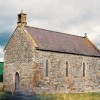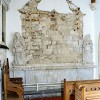Steeple is a small hamlet surrounded by heathland in the sparsely populated parish of the same name. Comprising a church, fine manor house and a few cottages, it is about four miles south west of Wareham between Lulworth and Corfe Castle at the foot of the Purbeck Hills. This rolling Dorset Down separates the hamlet from Creech Grange, the mansion and estate of special interest to American visitors because of the association with Sir Oliver Lawrence, an ancestor of George Washington. The Lawrence coat-of-arms featuring the stars and stripes is in the porch of the church and is repeated in the barrel roof and is the same as the coat-of-arms on a signet ring belonging to George Washington. Could this little place and nearby Affpuddle, which has similar features, be the birthplace of the stars and stripes?
The Lawrence and Washington families were from Lancaster and united through the marriage in 1390 of Edmund Lawrence to Agnes Wessington. Sir Oliver Lawrence came to Steeple and John Washington a descendent of Agnes, travelled to Virginia; his great grandson was George Washington, who became the first President of the United States of America.
In Domesday this place is referred to as Stiple a reference to the steepness of the hills. It was a part of the manor of Glole, Stiple and Criz or, as we would say today, Church Knowle, Steeple and Creech. We can see from the terrain surrounding the church that in medieval times Steeple was a large village. Now the church is quite isolated from the few cottages of limestone construction that make up Steeple today.
Before the Reformation the land hereabouts was owned by Bindon Abbey, but all that changed when Henry VIII ordered the dissolution of the monasteries in 1539. Sir Oliver Lawrence, the brother-in-law of King Henry’s Lord Chancellor, acquired the land and built Creech Grange here, completing it before his death in 1559. The house was bought by Nathaniel Bond in 1691, when the Lawrence line died out. Thomas Bond was made a baronet by Charles II and later turned an area of London known as Conduit Mead – at the time nothing more than a rubbish tip – into a habitable place. Today we know it as Bond Street the famous London Street synonymous with fashion and luxury shopping; many ladies will know that for many years Conduit Street was home in the UK to the Christian Dior label.
In 1682 the then Rector Samuel Bolde, dared to declare in a sermon that “everybody had a right to their own beliefs.” When word of this reached King James II he was not well pleased and Rector Bolde found himself in prison.
The parish church is dedicated to St. Michael. Built from rubble and ashlar and roofed with stone slates it comprises nave, chancel, south chapel, north pew, south porch and west tower. Much of the nave survives from the 12th century; it has a 17th century plaster barrel vault, which was renewed in 1954. Edward Lawrence sponsored several alterations and additions during the 17th century including the building of the west tower. The chancel and south porch were rebuilt between 1852 and 1861.
The Manor House was built at the start of the 17th century and later enlarged probably in 1698. On the front of the building there is the Clavell family crest probably commemorating the additions to the building by Roger and Ruth Clavell and they made further additions at the beginning of the 18th century. The extensive additions made to the north east of the house are modern.
To see the other important buildings in the parish we have to climb some 700 feet to the top of the downs and Grange Arch. Built in the 18th century by Denis Bond “to form an architectural focus to the view southward from the Grange” says the RCHM. From this vantage point we can look down on the mansion known as Creech Grange.
The impressive house we see today owes little to the original building, which was badly damaged by the Parliamentarians during the Civil War. The front of the building was completely rebuilt in 1846 by the Bond family.
Near to the grand house is the Chapel of St. John the Evangelist built in 1746 by Denis Bond, who died before it was completed; for a century the unfinished building was used as a workshop. Originally it consisted of a west tower and nave with a small sanctuary entered through a 12th century archway, brought from the priory church at East Holme and according to the RCHM is a “notable Romanesque feature.” It was 1840 when work was recommenced by John Bond who died in 1844. His brother the Revd Nathaniel Bond rebuilt the nave and tower and added the north transept in 1849. 1868 saw the addition of the chancel, the vestry and organ chamber.
Every parish, village and hamlet has a history deserving to be told and Steeple, with its associations with America’s founding fathers, its outspoken clergy, and the transfer of its grand mansion from a distinguished Royalist family to another prominent family is no exception.



